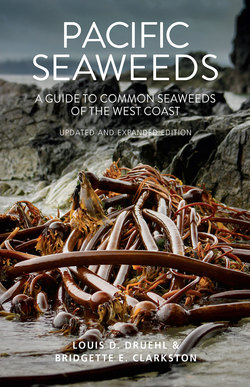Читать книгу Pacific Seaweeds - Louis Druehl - Страница 43
На сайте Литреса книга снята с продажи.
ОглавлениеShore Plants and Seagrasses | 43
Identifying Pacific Seaweeds
California. Reported to be infrequent on Haida Gwaii and Vancouver Island in BC, and are included in the California Native Plant Society Inventory of Rare and Endangered Plants.
Lathyrus japonicus (var. maritimus) Beach pea
Angiospearmae Family Fabaceae
Description
Lathyrus (Greek=vetch, common name for pea plants) japonicus var. mari-timus is a perennial herb. A rhizome produces stems up to 10–150 cm (4–59 in) long that creep along the landscape via grasping tendrils. Leaves are div-ided into 6–10 oval leaflets, each 1–7 cm (0.4–2.8 in) long and up to 4 cm (1.6 in) wide, arranged in an alternate or pinnate pattern. Flowers take the typical form for the pea family and are often two-coloured, a mix of blue, pink or purple. Seed pods are up to 7 cm (2.8 in) long, canoe-shaped and turn black when ripe, leading the Haida First Nation to give this plant the name “Raven’s canoe.” Each hairy pod contains up to 16 seeds that float in seawater, contributing to the transcontinental distribution of this species.
Habitat & Distribution
Beach pea is found on well-drained sandy or gravelly beaches and dunes, commonly around driftwood above the spray zone. Distribution is from Alaska to Northern California.
Lathyrus japonicus var. maritimus. Photo credit: Wikimedia Commons
